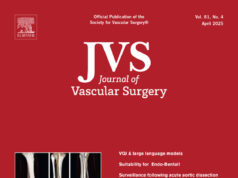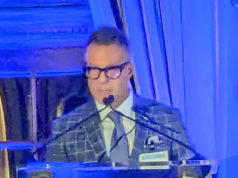Translumbar embolization had a greater technical efficacy than its transarterial equivalent in the treatment of type II endoleaks after endovascular aneurysm repair (EVAR), according to a systematic review and meta-analysis published in the Journal of Vascular Surgery.
As a result, lead author Qiang Guo, MD, of West China Hospital, Sichuan University, China, wrote, that the translumbar technique might be the better option in the treatment of patients who require reintervention.
Guo and his research team sought to compare clinical outcomes between the transarterial and translumbar (direct aneurysm sac puncture) approaches in the case of persistent type II endoleaks after patients had undergone EVAR procedures for an abdominal aortic aneurysm (AAA).
Type II endoleaks are caused by the backflow of collateral arteries into the aneurysm sac, the investigators explained, and are the most common complication of EVAR “with an occurrence rate of 22%.”
They continued, “Although most of the initially identified [type II] cases seal spontaneously, persistent [type II endoleaks are] associated with an increased incidence of adverse outcomes, including aneurysm sac growth and rupture.”
That’s why a consensus was reached that type II leaks persisting beyond six months with an increasing aneurysm size (>5mm) need reintervention, the authors added. The investigators trawled multiple electronic databases up to Oct. 31, 2018, for eligible trials that included patients with type II endoleaks after EVAR and evaluated the outcomes of translumbar versus transarterial embolization.
They determined the primary outcome of the study as clinical success—meaning absence of an endoleak after a final examination—with secondary outcomes of technical success and complication rate.
Odds ratios (ORs) with 95% confidence intervals (CIs) were estimated, the authors wrote, and among the 904 studies screened, nine spanning 354 participants were included in their review.
None of the studies reported rupture or mortality,” they explained. “The translumbar group had a relatively higher clinical success rate than the transarterial group, but this difference was not statistically significant (OR: 2.29; 95% CI, 1.00–5.25; p=0.05).
“The technical success rate was significantly higher in the translumbar group than in the transarterial group (OR: 13.32; 95% CI, 3.41‒52.07; p=0.0002). No significant difference was found in the complication rate of the two groups (OR: 1.15; 95% CI, 0.26‒4.96; p=0.85).”
In discussion, the authors observed that guidelines recommend imaging surveillance of one month after an EVAR procedure, then annually thereafter.
“However, a standardized treatment algorithm for the surgical management of persistent [type II leaks] with sac growth does not exist yet,” they wrote.
“Rahimi et al concluded that in treating patients with persistent [type II leaks] in the setting of sac enlargement, if two endovascular procedures fail to obtain control of the endoleak, repeated endovascular procedures are not recommended.
“They explained that a failed first attempt at the endovascular repair of persistent [type II leaks] is a strong predictor of future failure of endovascular interventions. Based on the results of this study, we suggest translumbar percutaneous sac puncture embolization as first-line treatment of persistent [type II leaks], and transarterial or transcaval embolization could be considered alternatively.”
In summary, the authors wrote: “Both translumbar and transarterial techniques are generally safe, causing rare postoperative morbidity and no mortality. However, translumbar technique had a superior technical efficacy over transarterial technique. Based on the current evidence, we suggest that the translumbar approach might be a better choice for patients with [type II endoleaks] that require intervention. Once repeated endovascular approaches have failed, open repair should be performed.”
SOURCE: DOI: 101016/j.jvs.2019.05.074












